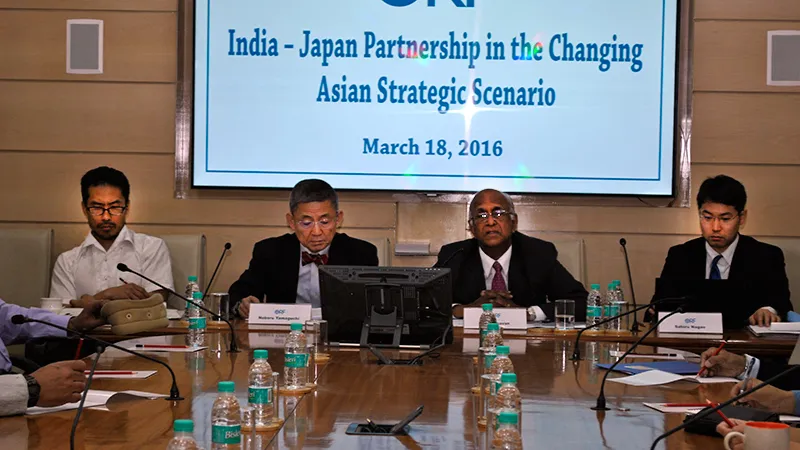Pointing out the escalating submarine race across the Indo-Pacific region, Dr. Satoru Nagao, a Japanese research scholar, has stressed that countries in the Indo-Pacific region are in the midst of a security dilemma regarding their maritime projection and are countering this by up-scaling production of submarines – considered symbols of tackling statist threats.
Dr. Nagao, Research Fellow at Tokyo Foundation, Lecturer on Strategy, Gakushuin University and Research Fellow at the Japan Forum for Strategic Studies in Tokyo said the coastal countries around the East China Sea have increased the number of submarines in their naval arsenal. This phenomenon has also come to light in the background of the changing power balance between the US and China.
Dr. Nagao was speaking at the conference on “India-Japan Partnership in the Changing Asian Strategic Scenario”, organised by Observer Research Foundation on March 18, 2016. Other key speakers were Prof. Noboru Yamaguchi of the International University of Japan and Prof. Toru Ito of the National Defense Academy of Japan. The conference was chaired by Prof. K.V. Kesavan, Distinguished Fellow, ORF.
Dr. Nagao said China had acquired 41 submarines in 2015, compared to the 11 built by the US. This is considered as part of a move by China to offset its naval weakness during the 1990s-2000s by modernising its submarine force. This is a maneuver to upgrade its sea denial capability, he said.
He pointed out that the traditional bilateral alliances (read US-Japan) with the US as a hub and Asian countries being spokes are not enough to counter these trends. A new alliance system is emerging with the spokes interacting amongst themselves, evidenced by the Japan-India-Australia and the India-Australia-Indonesia axis. He also stressed that the new alliance system must be flexible and could extend to Russia and China if they acted responsibly according to a prescribed set of rules.
Prof. Noboru Yamaguchi, a former General who spoke first, addressed the issue of the Japan-US alliance in light of the revised Japan-US Defence Guidelines. He said the revised Japan-US Defence Guidelines was necessitated by the need for better-integrated American and Japanese policy towards China, along with realistic economic relations (such as China joining the Trans-Pacific Partnership), a stronger combined military capabilities and more effective counters to Chinese aggression in the East and South China Sea.
He said the key objective of the Guidelines, signed on April 27, 2015, was to achieve a “seamless bilateral response” in dealing with strategic considerations in regional and global scenarios. And in the course of the deliberations between the delegations, it was learnt that the Japanese security framework allowed for responses in times of total peace and total war. There was a need for conceptualising responses to differential threat scenarios and mid-level threats.
Prof. Yamaguchi said the important areas considered were the assessment of varying dimensions of threat perception, the jurisdictions between ‘Use of Force (total war)’ and ‘Use of Weapons (law enforcement)’ and the options for response in the case of an attack on a friendly third nation (in this case, South Korea or the United States).
He said, finally, the Guidelines proposed a deepening alliance between the US and Japan via more institutional mechanisms such as the Strategic Dialogue, ACM, C2 Mechanisms, Defense Industrial Cooperation and a broadened cooperation across a wider geographical area (Korean Peninsula, for instance). Also, means of a sustainable alliance were discussed with the new perception of the USAF being considered as ‘tenants’ of the SDF, along with resolutions on long-standing Okinawa base issues.
Prof. Toru Ito discussed the subject of India-Japan Security Cooperation. He cited the historical landmarks in the progress of their security ties, such as the October 2008 Joint Declaration of Security Cooperation and joint naval exercises such as the Malabar Exercise setting forth naval maneuvers on a trilateral basis among US, India and Japan. He also pointed out the potential of an India-Australia partnership and its possible inclusion in the Malabar games.
A comparative assessment on India’s strategic partners conducted by the Foundation of National Security Research was highlighted in this context. The report had rated Japan’s defense cooperation with India at ‘0’ and its potential defense partnership at ‘2’ – officially claiming it to be a least likely defense partner for India.
The case for export of US-2 aircraft was brought up as a potential launch pad for a more integrated defense equipment partnership between the two countries. Furthermore, Mr. Ito suggested three possible areas of deeper cooperation – (1) Information-sharing and interoperability (citing maritime security and anti-piracy) (2) Freedom of navigation (3) Cooperation on stabilizing India’s neighbours.
This report is prepared by Mikhil Rialch, Research Intern, Observer Research Foundation, New Delhi.
The views expressed above belong to the author(s). ORF research and analyses now available on Telegram! Click here to access our curated content — blogs, longforms and interviews.




 PREV
PREV

